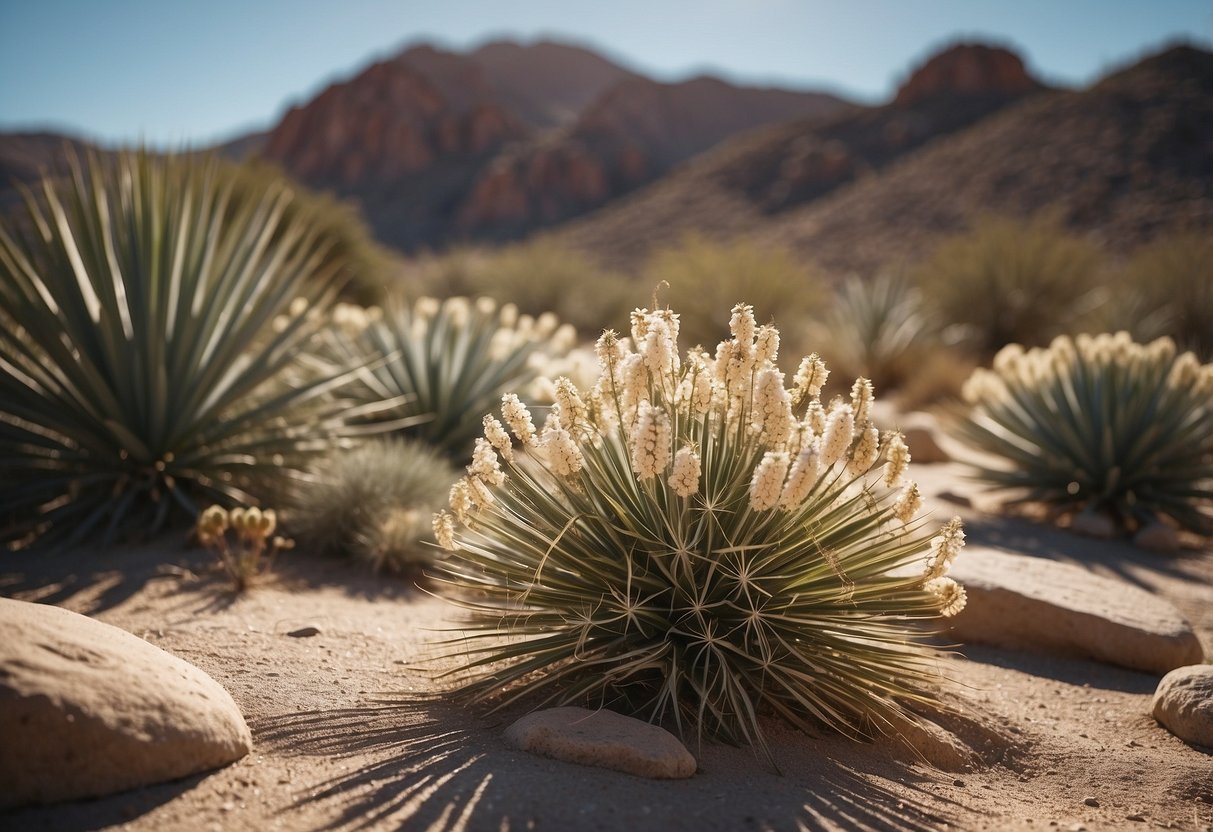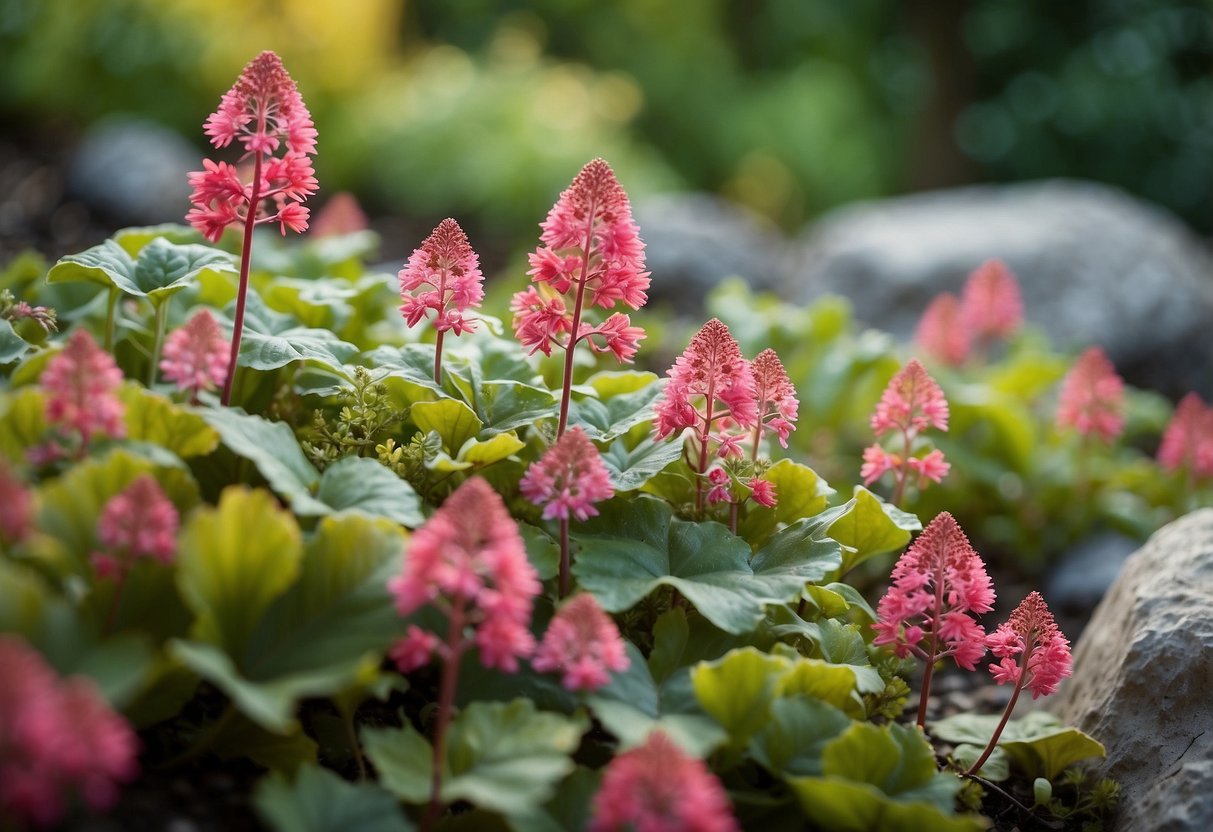Rock Garden Ideas Plants: Perfect Choices for a Stunning Landscape
Creating a rock garden in your yard can add both charm and practicality to your landscape. Rock gardens are designed to showcase the natural beauty of rocks and stones, while also providing a home for plants that thrive in well-drained, rocky soil.

Wondering which plants will thrive in your rock garden? A variety of plants, from small shrubs to creeping groundcovers, can complement the rugged terrain. Whether you’re looking to add color with flowering perennials or enhance textures with ornamental grasses, there’s a world of options to explore.
1) Blue Fescue

Blue fescue (Festuca glauca) is a popular choice for rock gardens. This ornamental grass grows about a foot tall and forms dense clumps. Its bluish-green color adds a unique touch to the garden.
Blue fescue thrives in dry, well-drained soil and requires full sun. It can also tolerate a bit of shade. This hardy plant is perfect for adding dimension and texture to your garden.
If you want a low-maintenance option, blue fescue is great. It mixes well with other rock garden plants and is resistant to drought. Your garden will look vibrant and appealing with this beautiful grass.
2) Creeping Thyme

Creeping thyme is a wonderful choice for your rock garden. It grows well in nutrient-poor soil and needs good drainage.
This plant is aromatic and can fill in spaces between stepping stones. It provides a soft contrast to the rough texture of rocks.
Creeping thyme can also help control erosion on slopes or embankments. It’s both practical and beautiful.
3) Sedum ‘Autumn Joy’

Sedum ‘Autumn Joy’ is a wonderful addition to your rock garden. It features beautiful maroon flower buds that bloom in late summer and autumn.
This plant thrives in full sun and well-draining soil. It’s heat and drought-tolerant, making it low-maintenance. You only need to water it occasionally.
If you want more information on how to grow Sedum ‘Autumn Joy,’ check out this guide. This plant can add vibrant color and texture to your garden, fitting perfectly with other hardy plants.
4) Agave

Agave plants are perfect for adding a touch of drama to your rock garden. They have thick, spiky leaves that form eye-catching rosettes.
You can choose from many types of agave, like Agave attenuata, which is known for its smooth, spineless leaves.
These plants are drought-tolerant and thrive in sunny spots, making them low-maintenance and ideal for your landscape.
Try grouping different agaves together for a variety of textures and sizes. They pair well with other succulents and add a unique, sculptural element to your garden.
5) Echinacea

Echinacea, also known as coneflower, is a great choice for your rock garden. It adds a splash of color with its bright, daisy-like flowers.
Plant Echinacea in a sunny spot with well-drained soil. It’s hardy and can thrive in various climates.
These plants are deer resistant and have few pests, making them low-maintenance. They also attract butterflies and bees, enhancing the natural beauty of your garden. To learn more, check out this guide to growing Echinacea plants.
6) Lavender

Lavender is perfect for adding color and fragrance to your rock garden. This hardy plant thrives in sunny, well-drained areas, making it an excellent choice for rock gardens. It grows well in poor soil and requires minimal maintenance.
Plant lavender along pathways or in clusters to create a vibrant purple accent. It pairs beautifully with other rock garden plants like sedums and thyme for a harmonious look. You can also try landscaping with lavender under trees.
7) Alyssum

Alyssum is a great choice for a rock garden. This plant is known for its tiny, sweet-smelling flowers that can add a splash of color to your garden.
It grows well in dry and sandy, well-drained soil. Alyssum blooms in clusters, creating a vibrant yellow display that is hard to miss.
Alyssum is also deer-resistant, making it easier to maintain your beautiful rock garden. It thrives best in areas with full sun but can tolerate light shade too.
8) Hens-and-Chicks

Hens-and-chicks are perfect for rock gardens. They are small succulents with lovely rosette-shaped leaves. These plants are easy to care for, making them great for beginners.
You should plant hens-and-chicks in sunny spots. They need at least six hours of sunlight each day to thrive. The colors become more vibrant with more sunlight.
Position them 12-18 inches apart as they will spread over time. They adapt well to shallow soil and are hardy in various climates. These succulents add a charming touch to any rock garden.
9) Yucca

Yucca plants are a fantastic choice for rock gardens. They love full sun and need at least six hours of direct sunlight daily. They thrive in well-drained, slightly acidic to neutral soil.
Pairing yucca with other drought-tolerant plants, like herbs and succulents, can create a beautiful, water-wise garden. For smaller spaces, try the dwarf nana variety.
Yucca plants can also attract birds, bees, and butterflies, making your garden lively and dynamic. Try to include different yucca varieties to add texture and interest to your rock garden.
Learn more about planting with yucca at Practical Planter.
10) Coral Bells

Coral Bells are a wonderful choice for your rock garden. They add splashes of color with their bright foliage and delicate flowers. These plants are native to woodlands, making them well-suited for shaded areas.
You can find Coral Bells in various colors, from silver to nearly black. Their flowers attract butterflies and hummingbirds.
Plant Coral Bells in spring or fall. They thrive in rich, well-draining soil but can also tolerate clay or rocky soils. Space them 1-2 feet apart for the best results.
Choosing Plants for Your Rock Garden

When choosing plants for your rock garden, it’s important to consider the hardiness of the plants as well as selecting those that are low-maintenance. These factors will contribute to a vibrant, sustainable garden that suits your environment and lifestyle.
Understanding Plant Hardiness
Plant hardiness is key when planning your rock garden. This refers to a plant’s ability to survive in your climate. The USDA Plant Hardiness Zone Map is a helpful tool for determining which plants will thrive in your area. For example, rock cress (Aubrieta deltoidea) does well in zones 4-8, offering blooms from spring to summer.
Choosing plants like blue fescue (Festuca glauca), which thrives in zones 4-8, ensures your garden remains healthy throughout the year. Consider cold-hardiness for northern regions and heat tolerance for southern areas. Alpine plants are often great choices due to their natural adaptation to rocky environments and variable conditions.
Selecting Low-Maintenance Plants
Opting for low-maintenance plants means less effort and more enjoyment. Succulents and drought-tolerant plants are excellent choices. They require less water and are perfect for well-drained, rocky soil. For instance, succulents add color and texture while needing minimal care.
You can also consider perennials and ornamental grasses. These plants not only add beauty but also require less upkeep. Perennials like Euphorbia can be planted in large, flat dishes and brought indoors during frost, making them versatile and easy to manage year-round.
By choosing the right plants, you’ll enjoy a lush and beautiful rock garden without the need for constant maintenance.
Designing Your Rock Garden

Creating a rock garden involves thoughtful planning and careful selection of elements to ensure a harmonious and balanced look. Pay attention to making smooth transitions and consider adding water features for a soothing touch.
Creating Natural Transitions
Smooth transitions are key to a cohesive rock garden design. Use creeping groundcovers like sedum or thyme to create a natural flow between rocks. These plants soften the hard edges and add a lush, green appearance.
Integrate ornamental grasses and small shrubs to add vertical height and break up the flat rock surfaces. Grasses such as blue fescue or fountain grass work well. Perennials like lavender or dianthus provide color and interest.
Vary the size and texture of your rocks. Combine large boulders with smaller stones and Mexican pebbles to create a natural look. Make sure the rocks appear partially buried to mimic natural landscapes.
Integrating Water Features
Water features can enhance the tranquility and appeal of your rock garden. Consider a small pond or a dry creek bed with pebbles and small rocks. These elements add both visual and auditory interest.
If space allows, add a small waterfall or fountain. The sound of flowing water is calming and can attract birds and other wildlife to your garden. Use native plants around the water feature to create a seamless look.
Ensure your water feature complements the surrounding landscape. Choose rocks and stones that match those used in the rest of your garden. Properly maintain the water elements to prevent algae buildup and ensure clear, clean water.
Maintaining Your Rock Garden

Maintaining your rock garden involves proper watering techniques and seasonal care to ensure your plants thrive. Here are some tips to keep your garden looking its best.
Watering Techniques
Rock gardens typically need less water compared to traditional gardens. Soaker hoses or drip irrigation systems work best. These methods deliver water directly to the roots, minimizing waste and preventing soil erosion.
It’s important to water in the morning. This allows the soil to absorb moisture before the heat of the day. Avoid overhead watering to prevent fungal diseases. Misting can help succulents and other drought-tolerant plants maintain hydration without over-watering.
Check the soil moisture regularly. Stick your finger about an inch into the soil. If it feels dry, it’s time to water. This helps prevent overwatering, which can damage plants in a rock garden.
Seasonal Care Tips
Each season presents its own challenges and needs for your rock garden. In the spring, remove any debris and replenish mulch to conserve moisture and regulate soil temperature. Prune any dead or damaged plant parts to encourage new growth.
During the summer, be mindful of pests and diseases. Regularly inspect plants for any signs and treat them promptly. Provide shade for plants sensitive to intense sunlight using shade cloths or strategically planted taller plants.
In the fall, clean up fallen leaves to prevent them from smothering plants and causing mold. This is also a good time to plant bulbs that will bloom in the spring.
Winter care is crucial if you live in colder climates. Cover sensitive plants with burlap or bring potted plants indoors. Ensure your garden has good drainage to prevent water from freezing around the roots and damaging them.







